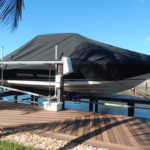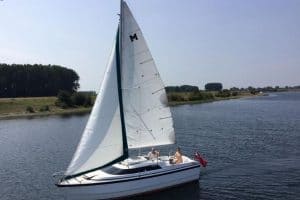Do you want to learn to sail but are not sure if it will take too long or be too difficult? It can look difficult on the outside, but it isn’t so hard.
How hard is it to learn to sail a boat? Learning to sail a boat is not that hard; it just takes some time, patience, and knowing the ins and outs. To learn faster, you must learn the following:
- Basic sailing tips
- Basic sailing terms
- Best sailing practices
- Sailboat buying tips
Read on to learn more about each of these important things to know. As you gain more knowledge, it will become easier and easier to master the art and science of sailing!
Basic Sailing Tips
Sailing is not always about speed, and if you’re new to sailing, this is an easy mistake to make. Here are a few sailing tips for beginners.
- Beginners will benefit from sailing on calm waters that are not crowded. This will help you practice your sailing skills and help you get used to how the winds and traffic will interfere with sailing.
- Sailing on a small boat first is the best way to start. It will be easier for you to learn how to sail when dealing with fewer sailboats and lines.
- You should research the wind, weather, and tide conditions before heading out. This will also help you bring the correct provisions, clothing, and appropriate gear for the weather.
- This may seem weird, but beginners should capsize their sailboat on purpose. This will help in learning how to handle the situation.
- Beginners should also learn the basic sailing terms, which is the next topic we will discuss.
Basic Sailing Terms
- Bow – this is the front of the boat. Anything that is near the front of the boat is called “forward.”
- Stern – this is the back of the boat. Anything near towards the back of the boat is called “astern” or “aft.”
- Port – this is the left side of the boat when you are facing the bow.
- Starboard – this is the right side of the boat when you are facing the bow.
- Helm – this is where you steer the boat and control the boat’s rudder. This is usually a big wheel, but it is a tiller or a large wooden stick on smaller boats.
- Keel – this is a long heavy fin located at the bottom of the boat that is submerged in water. The keel is responsible for keeping the boat stable.
- Lines – when you are sailing, this is what you call the ropes.
- Mainsail – this is the largest and most important sail. The mainsail has a thick pole called the boom that runs along its bottom edge.
- Leeward – this is the direction opposite of where the wind blows.
- Windward – this is the opposite of leeward, as it is the direction where the wind blows. It’s important to know this because most sailboats move with the wind.
Knowing these sailing terms is an important step in sailing. Using these sailing terms will make you sound like you know what you’re doing. And with time and practice, you will know better what you’re doing!
For more advanced terms, check out the following video:
Best Sailing Practices
All boaters and the ships they sail impact the waters they sail on. It’s important to keep the waters as though we were never there and protect the marine environment. As sailors, how you sail, where you sail, and what products you use on your boat affect the waters.
The little things you do today will matter in the future. As such, you should always practice clean sailing. Here are a few best sailing practices to help you get started.
Check for Drips and Other Oil Discharge
Keeping your engine in top shape is beneficial not only for you but the waters as well. This will ensure that there are no fuel and oil leaks.
Placing an oil absorbent pad in the bilge and where the drips can occur is a great way to prevent this. You can then dispose of this as hazardous waste.
Take Extra Care During Oil Changes
Wrapping a plastic bag or absorbent pad around the oil filter to prevent spills when you change oils may seem like a small thing, but it really helps in keeping oil from dripping unnecessarily in the water.
Keep Your Trash with You
At least until you dock. Do not throw cigarette butts or any garbage in the ocean. There will be plenty of facilities where you can even recycle your waste products when you dock.
Dispose of Sewage Waste Properly
Responsible sailors never throw sewage within 3 miles from the shore. There are shoreside facilities and pump-out stations that you can use. If your boat does not have a toilet installed, make use of a port-a-potty and dispose of it properly.
Avoid Boat Maintenance in Open Water
Keep your maintenance projects when you’re in the boatyard and not in open water. This will help in preventing unnecessary waste from contaminating the water. Use tarps to collect drips and debris and dispose of them properly.
It may seem like a small thing, but washing your dishes and taking showers while onshore is another way you can help minimize waste from entering our waters. If you do these things while you’re still onshore, the residue from the soap, shampoo, dishwashing liquid, and other stuff we use will go straight to the sewers and not in open water.
Keeping your waste off the water will help keep our waters clean. Going green and becoming a responsible sailor matter now and in the future. We should strive to leave an invisible footprint wherever we go. Sure, the waters are not completely clean, but that doesn’t mean we should pollute it even more.
Sailboat Buying Tips
Just as important as it is to address our main question: “How hard is it to learn to sail a boat?” we need to talk a bit about the question “How to choose the right sailboat?” When you’ve learned how to sail, you’ll probably start looking into buying a sailboat of your own. You’re probably wondering, what kind do I buy?
You will naturally gravitate to something small since this is what most people would recommend. As you learn and become better at sailing, you can move up to bigger ones. Most adults will start with a keelboat or a boat that is around 22-27 feet.
Boats of this size are great since it’s easy to sail, it will have plenty of room, and it is generally safe and affordable. You can bring people along with you and still have space for your gear. Most boats this size will have a head (a toilet) and maybe even cooking facilities.
Some of the things you should keep in mind when choosing the right sailboat are the activities you’re interested in, how many passengers you want to be able to take with you, the type of engine it will have, and how you want to transport your boat – will it be kept at a marina or will you trailer it around?
If you sail often, your sailing skills will develop pretty quickly. As such, it’s better if you buy a boat that’s popular in your area, particularly those with sailors who race. Even if you don’t currently race, soon you will want a boat that can race.
A boat that can perform well partnered with your growing sailing skills will give you more fun. And when you want to upgrade, you’ll find it easier to sell your boat if there are racers nearby.
For more tips on buying a sailboat, see this video:
Conclusion – How Hard Is It to Learn to Sail a Boat?
To revisit our initial question: “How hard is it to learn to sail a boat?” It is not so hard as long as you familiarize yourself with the following:
- Basic sailing tips
- Basic sailing terms
- Best sailing practices
- Sailboat buying tips
Sailing is a fun activity and an excellent hobby. You can go sailing by yourself, with your friends and family, and even participate in races and compete with other sailing enthusiasts.
When you’ve learned how to sail and you have the right sailboat, you will have hours of fun on the water. Just remember that the more you sail, the more you’ll be able to hone your skills.
Getting the right sailboat for you is also important – it should match your sailing skills and more as you get better.
Knowing the parts of your boat and using the right sailing terms is also important, especially when you’re speaking with other sailors. You’ll know exactly what they’re talking about!
Most importantly, all sailors affect the waters they sail on. With this in mind, it’s better to leave a positive effect than a negative one by practicing clean boating habits. These may seem like small things, but a little does go a long way in keeping trash and other waste off the waters.
With these tips and best practices, you will learn to sail in no time with ease!
Related reading:






![Boat Floor Replacement Plywood [Best Options] boat floor replacement plywood](https://boatinggeeks.com/wp-content/uploads/2021/07/boat-floor-replacement-plywood-150x150.jpg)


